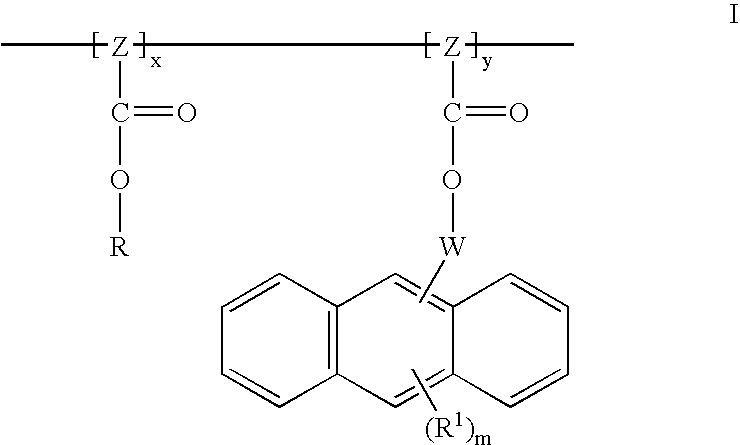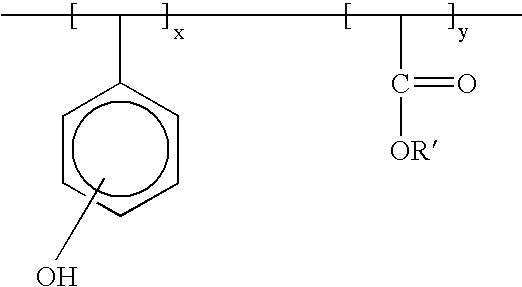Dyed photoresists and methods and articles of manufacture comprising same
a technology of photoresists and dyes, applied in the field of new photoresist compositions, can solve the problems of unsatisfactory photoresist resolution, inability to provide such high-resolution fine line images, and often limiting the resolution of image patterned, so as to reduce the reflection of exposure radiation
- Summary
- Abstract
- Description
- Claims
- Application Information
AI Technical Summary
Benefits of technology
Problems solved by technology
Method used
Image
Examples
example 1
Preparation of Preferred Dye Resins
1. Preparation of Monomers with Chromophores.
[0077]A. Preparation of Chloroxine Methacrylate.
[0078]A 500 ml round bottom flask equipped with magnetic stirrer and nitrogen inlet was charged with 5.0 g (0.0234 mol) 5.7 dichloro-8-hydroxyquinoline (chloroxine), 2.01 (0.0234 mol)methacrylic acid, 500 ml methylene chloride, 1.43 g (0.5 eq.), 4-dimethylamino-pyridine (DMAP) and 6.72 g 1-(3-dimethylamino propyl)-3-ethylcarbodimide (EDCI). The reaction mixture was stirred under a blanket of nitrogen for 12 hours at 25° C. The product was purified by column chromatography (methylene chloride) to give a pale yellow solid (yield 67%).
[0079]B. Preparation of Methylanthracene Methacrylate
[0080]Methylanthracene methacrylate (CH3C(═CH2)CO2CH2-9-anthracene) was prepared as disclosed in Macromolecules, 17(2):235 (1984).
2. Preparation of Resins.
[0081]Methylanthracene methacrylate (ANTMA) / hydroxyethyl methacrylate (HEMA) copolymer (Formula III below) was prepared as ...
example 2
[0085]A solution consisting of 10.664 g of ANTMA / HEMA dye solution (5 wt % of ANTMA / HEMA resin of Formula III in ethyl lactate), 2.664 g polyhydroxystyrene-t-butylacrylate copolymer solids, 0.126 g Silwet™ L-7604 Surfactant solution (10% solids in Ethyl Lactate) and 6.525 g additional ethyl lactate was prepared. The solution was filtered through a 0.2 μm pore-size PTFE membrane filter.
[0086]Solutions of other dye materials were also formulated, using the same dye concentration as the ANTMA / HEMA copolymer. Those dyes are specified in Table I below. A sample with no dye material was also evaluated.
[0087]Quartz and silicon wafers were coated with the dyed polymer solutions for determining optical properties. Wafers were soft baked for 60 seconds at 100° C., vacuum hot plate, on a GCA MicroTrack coat and bake system. Silicon wafers were used for thickness and cauchy coefficient determinations. Absorbance spectra from 200 nm to 500 nm were taken on a Cary 13 UV-VIS Spectrophotometer; abs...
example 3
[0089]A photoresist composition (Resist 1) consisting of 6.083 g polyhydroxystyrene-t-butylacrylate copolymer solids, 2.432 g di-t-butylphenyliodonium camphorsulfonate photoacid generator solution (10 wt % solids in ethyl lactate), 0.136 g of a tetrabutyl ammonium hydroxide lactate solution (10 wt % solids in ethyl lactate), 0.181 g ANTMA / HEMA dye solution (34 wt % solids in 37.5 vol % Anisole:62.5 vol % propylene glycol monomethyl ether acetate), 0.322 g Silwet™ L-7604 Surfactant solution (10 wt % solids in ethyl lactate) and 30.850 g additional ethyl lactate was prepared.
[0090]Two additional photoresists (Resist 2 and Resist 3) were formulated in the samme manner as for Resist 1 and described about, except the amount of ANTMA / HEMA dye solution was varied to adjust the optical density of the photoresist film: Resist 2 contained 0.524 g of the ANTMA / HEMA dye solution and Resist 3 contained 0.864 g of the ANTMA / HEMA dye solution. Resists 1–3 thus contained 1, 3% and 5% dye solids (wt...
PUM
| Property | Measurement | Unit |
|---|---|---|
| weight average molecular weight | aaaaa | aaaaa |
| optical density | aaaaa | aaaaa |
| mole fraction | aaaaa | aaaaa |
Abstract
Description
Claims
Application Information
 Login to View More
Login to View More - R&D
- Intellectual Property
- Life Sciences
- Materials
- Tech Scout
- Unparalleled Data Quality
- Higher Quality Content
- 60% Fewer Hallucinations
Browse by: Latest US Patents, China's latest patents, Technical Efficacy Thesaurus, Application Domain, Technology Topic, Popular Technical Reports.
© 2025 PatSnap. All rights reserved.Legal|Privacy policy|Modern Slavery Act Transparency Statement|Sitemap|About US| Contact US: help@patsnap.com



